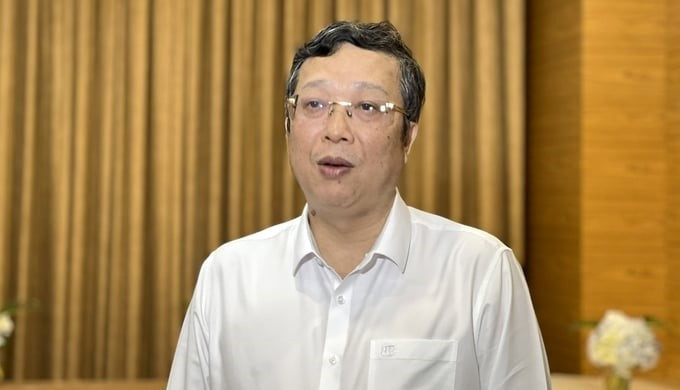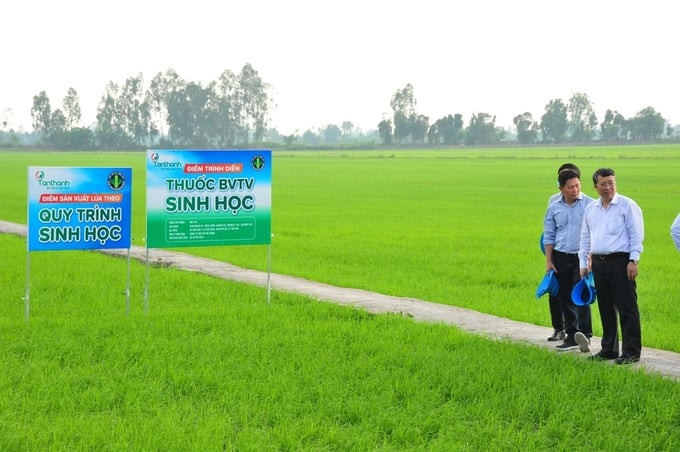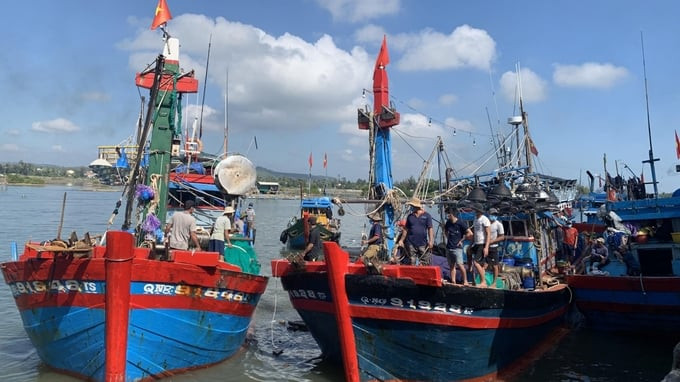
Deputy Minister of Agriculture and Rural Development Hoang Trung
The use of biopesticides is increasing
At the conference "Developing the production and use of biopesticides" organized by the Ministry of Agriculture and Rural Development (MARD) in Ho Chi Minh City on November 2, Mr. Huynh Tan Dat, Director of the Plant Protection Department, said that as of now, in the List of Pesticides Allowed for Use in Vietnam, there are 810 biopesticide names.
Biotechnology in Vietnam is currently being prioritized and brought to an industrial scale, especially in the agricultural field. In the field of pesticides, biopesticide production technology is one of the production technologies that is being paid attention to and increasingly applied in production.
Current biopesticide production technologies include microbiological technology, plant extraction technology, and finished medicine production technology from active elements belonging to the biochemical group.
There are now 85 biopesticide production facilities. These facilities all apply the quality management system according to ISO 9001 standards and the environmental management system that meets ISO 14001. Most facilities have a quality testing laboratory accredited to ISO 17025.

Deputy Minister Hoang Trung inspected rice production sites according to biological processes in the Mekong Delta
In addition, popular biopesticide production technologies in the world have been registered, produced, and applied in Vietnam, such as nano-biopesticide production, the production of biopesticides extracted from herbs, the production of biopesticides containing microorganisms, virus- or nematode-derived drugs, etc.
In particular, regarding the use of pesticides, data from localities shows that in the last three years (2020–2022), the average total amount of pesticides used nationwide has decreased gradually over the years, from 3.81 kg/ha in 2020 to 3.19 kg/ha in 2022. Of which, the average amount of biopesticides used nationwide was still at a stable level and increased from 16.67% in 2020 to 18.49% in 2022.
Deputy Minister of Agriculture and Rural Development Hoang Trung said that the above-mentioned information on the production and use of biopesticides is the initial basis and important foundation to accelerate the development and use of biopesticides in the coming time.
Creating favorable mechanisms for biopesticides
Dr. Nguyen Xuan Hong, former Director of the Plant Protection Department, said that it is necessary to determine that the main purpose of promoting the production and use of biopesticides is to improve the effectiveness of plant protection, reduce chemical use, ensure food safety, protect the environment, and develop sustainable agriculture.
To achieve this goal, Vietnam needs to attach importance to all three main directions, including: developing the production and use of domestic biopesticides; importing and using good-quality, highly effective biopesticides; and guiding and supporting farmers in self-producing biopesticides on scales of farmer households, farms, cooperative groups, or cooperatives.
In order to promote the production and trade of biopesticides in the country, delegates proposed many practical solutions. These include the need to innovate regulations on pesticide management in Vietnam towards separating regulatory content on the management of registration, production, and use of biopesticides; concretizing the concept of biopesticides in Vietnam; supplementing regulations on some new biopesticides; simplifying procedures; promulgating a List of Safe Biopesticide Active Elements Prioritized for Quick Registration, etc.
According to Dr. Nguyen Xuan Hong, many countries and regions around the world are applying good solutions to develop production, business, and use of pesticides, which Vietnam can learn from. For example, Korea is widely developing the practice of introducing and selling biopesticides online, thereby contributing to promoting the production and use of biopesticides. While online sales of biopesticides are allowed, Korea does not allow applying this form of sale to chemical pesticides.

Farmers in the Mekong Delta use biopesticides in rice fields
In Thailand, there is a regulation on fast registration channels. There is also an initiative to issue a List of Low-Risk Biological Drugs. For products made from active elements in the List of Low-Risk Biological Drugs, toxicological testing is not required, so the waiting time for registration is shortened to about 6–12 months. Thanks to that, in 2021, the number of biologically active elements in this list increased from 5 to 17.
Dr. Tony Alfonso, Chairman of CropLife Asia's Working Group on Biopesticides, also emphasized the importance of implementing a predictable and appropriate legal system for biopesticides. This system aims to ensure the consistent safety and effectiveness of products without restricting the introduction and trade of biopesticides on the market. Of which, there is a need for separate registration and management guidelines for pesticides and strict quality control mechanisms.
Speaking at the conference, Deputy Minister Hoang Trung highly appreciated the delegates' speeches with practical solutions for developing the production and use of biopesticides in Vietnam.
The Deputy Minister affirmed that MARD highly appreciates the efforts of the business community, associations, and localities that have accompanied and created positive results in promoting the application of biopesticides in recent times, such as: building biopesticide-using models; changing people's awareness and thinking; creating biopesticide products and applying them to production.
MARD encourages businesses, together with specialized agencies of the Ministry as well as localities, to build effective biopesticide application models for each specific crop, especially those staple crops, and for each harmful organism. Thereby ensuring that people will gradually become familiar with biopesticides and have the habit of prioritizing the use of biopesticides when needing to use pesticides.
In addition, the Ministry will integrate the use of biopesticides into programs such as integrated pest prevention and control and integrated crop health management and establish the List of Biopesticides Used in Organic Agricultural Production.
MARD’s goal is that by 2030, the proportion of biopesticides registered in the List of Pesticides Allowed for Use in Vietnam will reach 30%, and biopesticides will account for 20% of the total amount of pesticides used.
Translated by Huyen Vu Thu


















